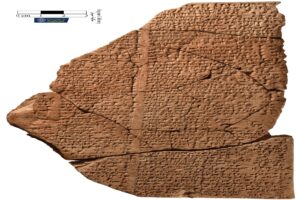It was one of the first stories I ever learned in Sunday School. I remember the walls were ridden with images of rainbows, floods, arks, pairs of animals and an old man with a long beard with the brightest smile on his face after a great deluge.
Noah’s Ark is one of the Bible’s most iconic stories. It involves God’s punishment against humanity’s iniquity in the form of a flood that washes away most of the known Earth. Society can then rebuild anew.
To survive the calamity, God ordered Noah to build the ark for his family and the animals of the Earth. His peers mocked him, but the ark dwellers were the only survivors.

The mound in Turkey that resembles an ark. Photo: MehmetO/Shutterstock
Many view this as an allegory to teach us about the consequences of sin. But is there any truth to this event? Maybe so! The search for the ark has been ongoing since 275 AD. Many possible sites have been identified, and excavations have suggested that a cataclysmic geological event did indeed take place. Let us examine what we know.
What did the ark look like?
In the Bible, God told Noah that “the length of the ark is to be three hundred cubits, its breadth fifty cubits, and its height thirty cubits.” This is equivalent to 134m long, 22m wide, and 13m high. He also told Noah to use “resinous wood” and pitch. With regard to the animals, he had to take a pair (male and female). To accommodate such a hefty cargo, he likely needed multiple levels to house them. According to Jewish texts, the ark might have had three levels to represent Heaven, Earth, and Hell.
Other cultures and religions have a similar legend. Many historians link this story to the flood myths of Mesopotamia. The Epic of Gilgamesh has obvious similarities to the biblical story but varies in certain details. The tale speaks of the ark as a cube with six decks. In Islam, writers describe it as an ordinary-sized ship. In the Bahá’í faith, the story is simply symbolic.
What happened after the flood?
The deluge went on for 40 days and 40 nights. After 150 days, the waters fully receded, and “the ark came to rest on the mountains of Ararat.” Mount Ararat is a volcano bordering both Turkey and Armenia. There is confusion as to whether or not the final resting place of the ark was the physical mountain or if the word was a mistranslation for something else. Some scholars suggest that Ararat might be Hebrew for the Iron Age Kingdom of Urartu, which was also in Armenia.

Reconstruction of the ark on a mountaintop. Photo: photostockam/shutterstock
According to the Bible, Noah burnt offerings to God, who promised not to flood the Earth again. Noah and his sons then went forth and multiplied, per instructions. As for the ark itself, the Old Testament does not mention what happened to it.
The search
What became of the ark after the waters receded lies at the heart of the matter. Did it disintegrate? Was it disassembled for timber? Preserved via petrification? The search for the ark is affectionately called “arkeology.”
Some historians from antiquity, including Flavius Josephus, Epiphanius of Salamis, and John Chrysostom, agreed that the ark resided in Armenia near Mount Ararat. They called the area “the country of the Kurds.”
Over the centuries, many have claimed to be in possession of pieces of the ark. For example, an Assyrian king Sennacherib said he had a beam from the original ark, which he turned into a wooden idol statue. On the other end of the spectrum, some religious figures stated that it disintegrated.
In the 1800s, explorers from Europe climbed Mount Ararat and wrote that the ark was there. German explorer and naturalist Friedrich Parrot said that the locals did not dare approach the mountaintop out of fear of God and disturbing the ark. British politician James Bryce climbed the mountain in 1876 and claimed to have seen remnants of the ark’s wood.
Subsequent claims to the ark’s discovery have mostly been hoaxes or unsubstantiated hearsay from enthusiasts or con men.
Promising evidence
Surveys of the Mount Ararat region have shown possible signs of the ark. In 1959, a survey of Doğubayazıt, near the Iranian border in eastern Anatolia, highlighted an ark-looking feature in the land. It measured almost the same as the description in the Bible. This created considerable excitement among archaeologists until they verified that the shape was made solely of rocks and dirt.
Academics then passed it off as a natural formation. However, recent excavations found evidence of human activity, including seafood and clay objects dating back to 5500 BC. The Flood supposedly took place around this time. So far, this is the most promising evidence.
Other possible sites of the Ark include areas in Galilee, the Taurus Mountains, and the Caucasus Mountains. But some dismiss the notion that there ever was an ark.
Conclusion
Some cataclysmic event like a flood could indeed have occurred thousands of years ago. For a flood narrative to span so many cultures, and bear so many similarities, an actual environmental disaster is likely. If this did occur, humans could have survived by building a vessel.
Further excavations can show us whether humans really did settle high in the mountains, even briefly, until the waters receded. If we continue to dig until we come across more substantial evidence, like petrified wood and tools, we will be in a better position to draw conclusions.






